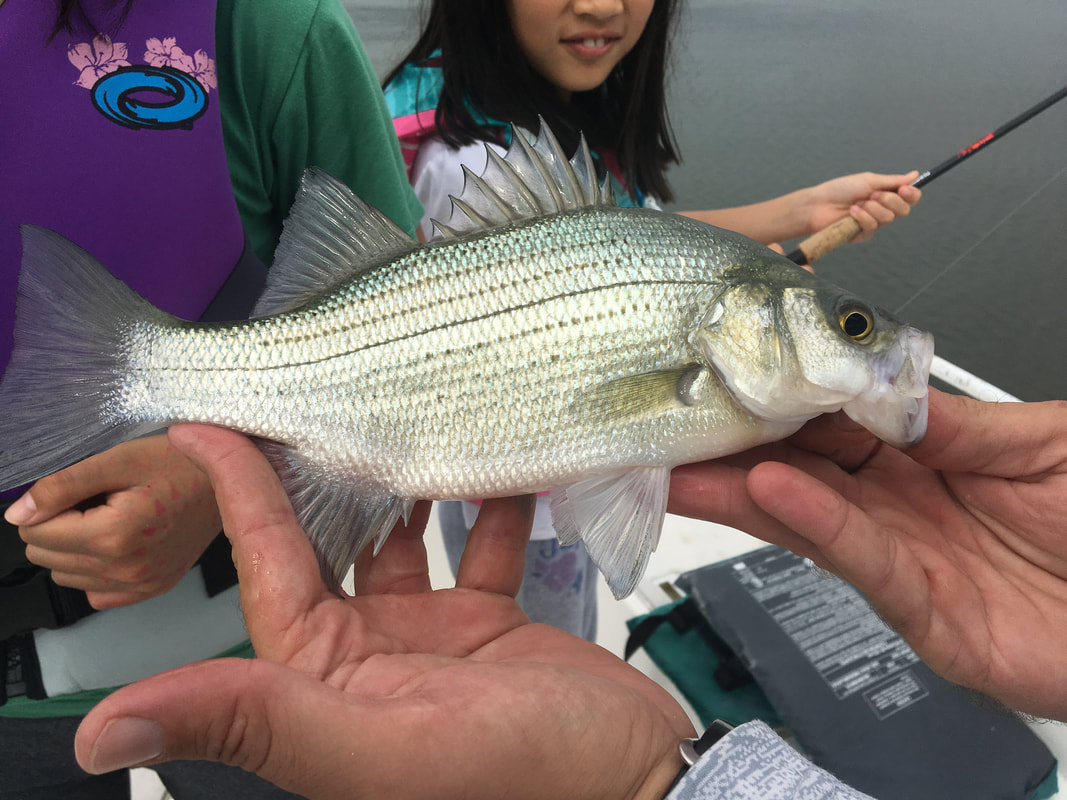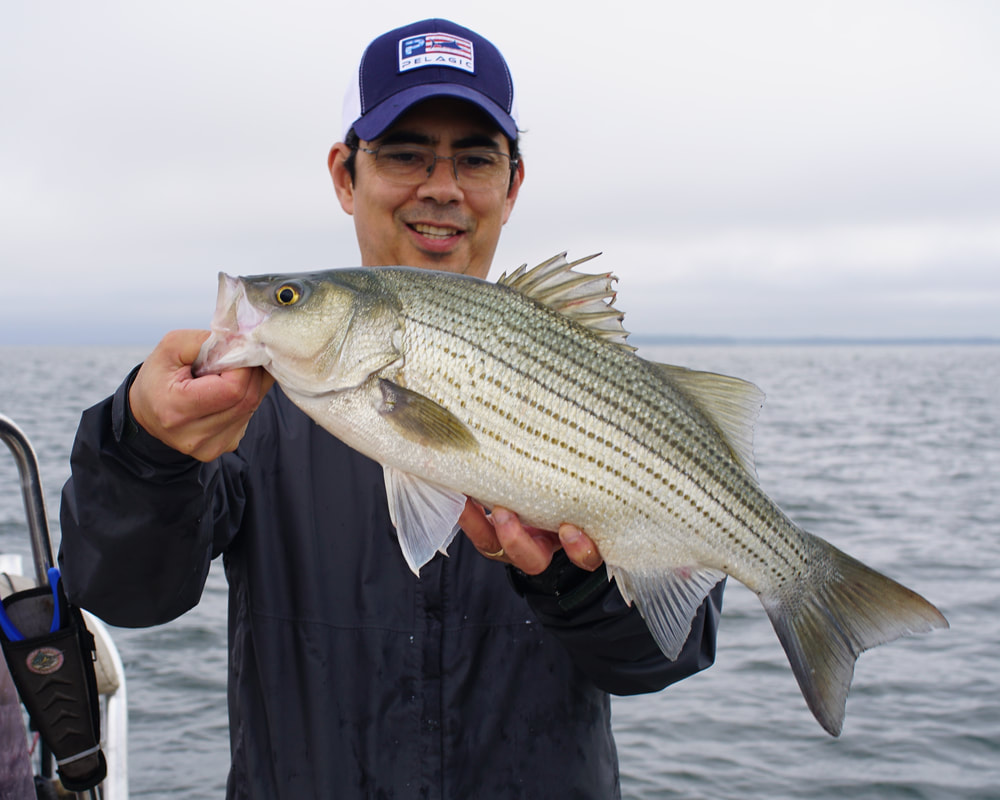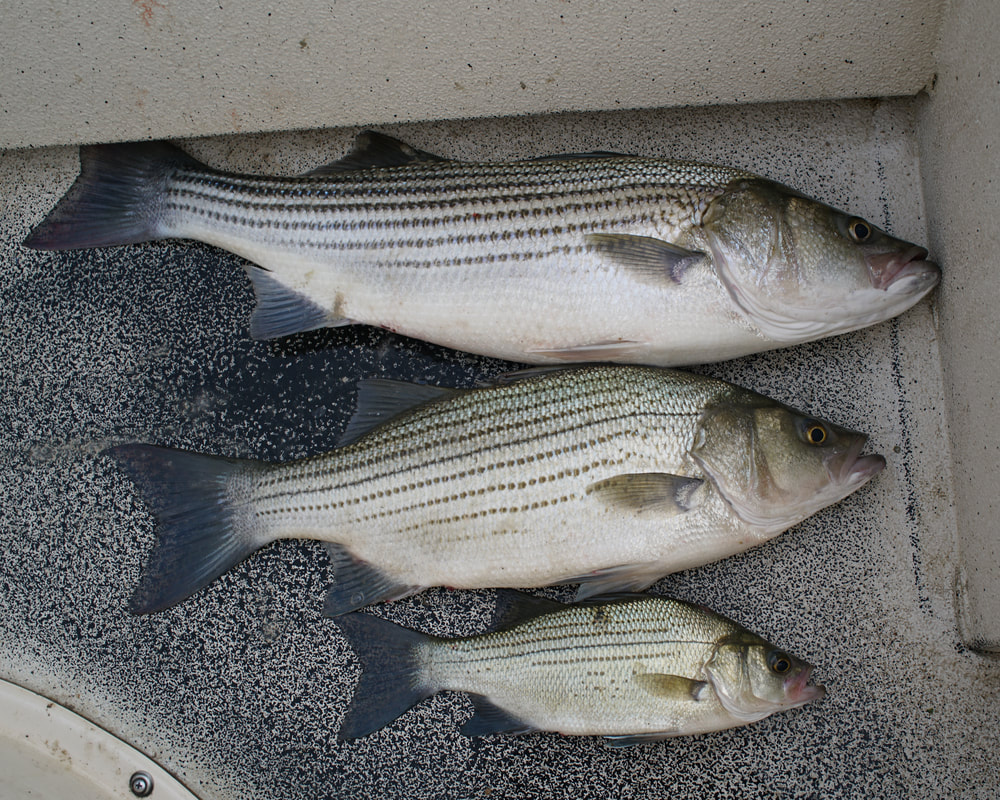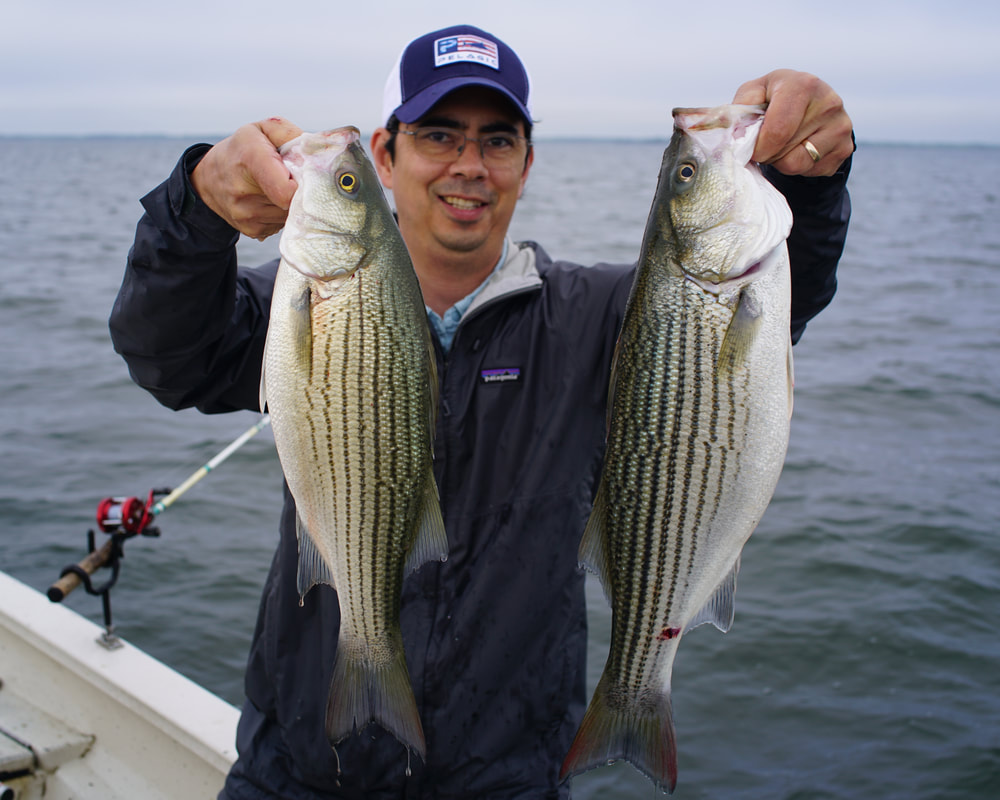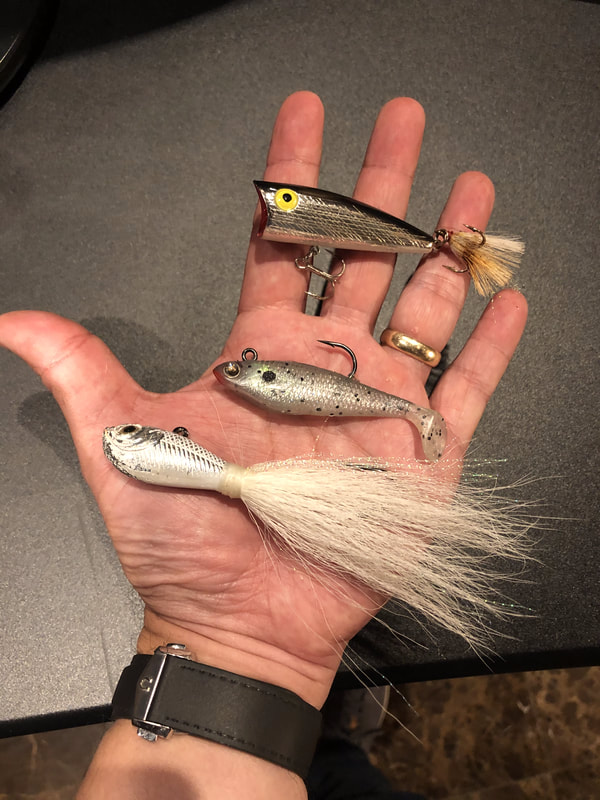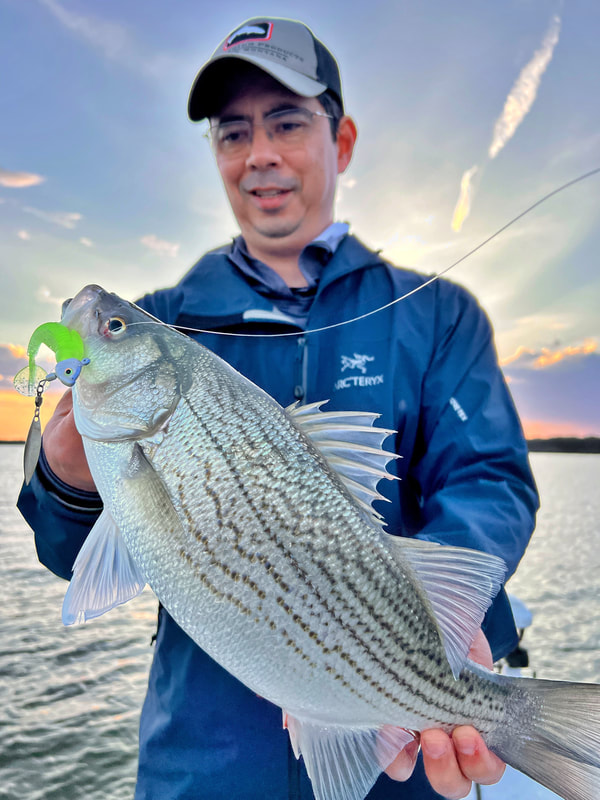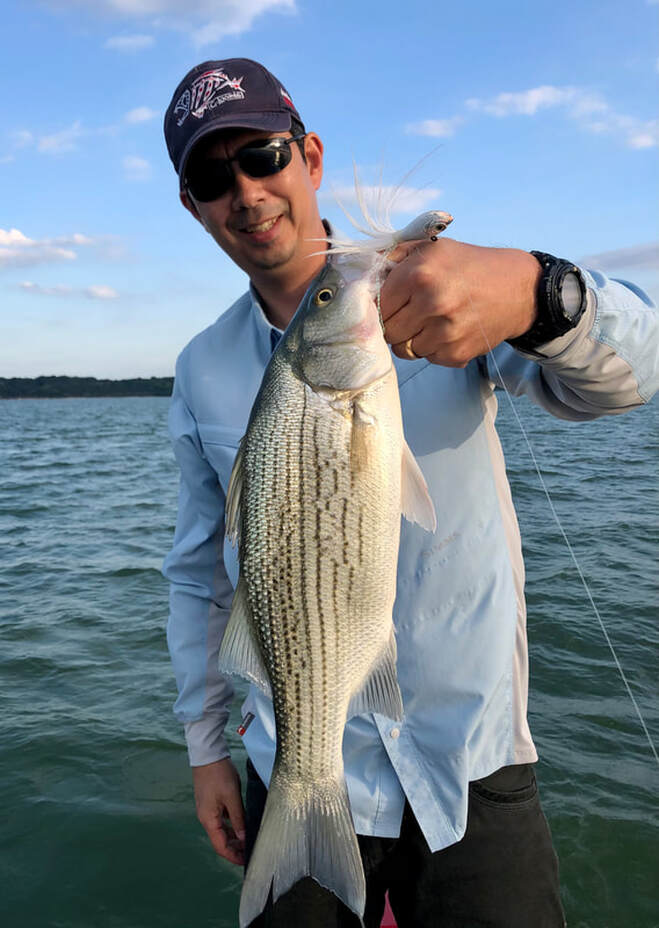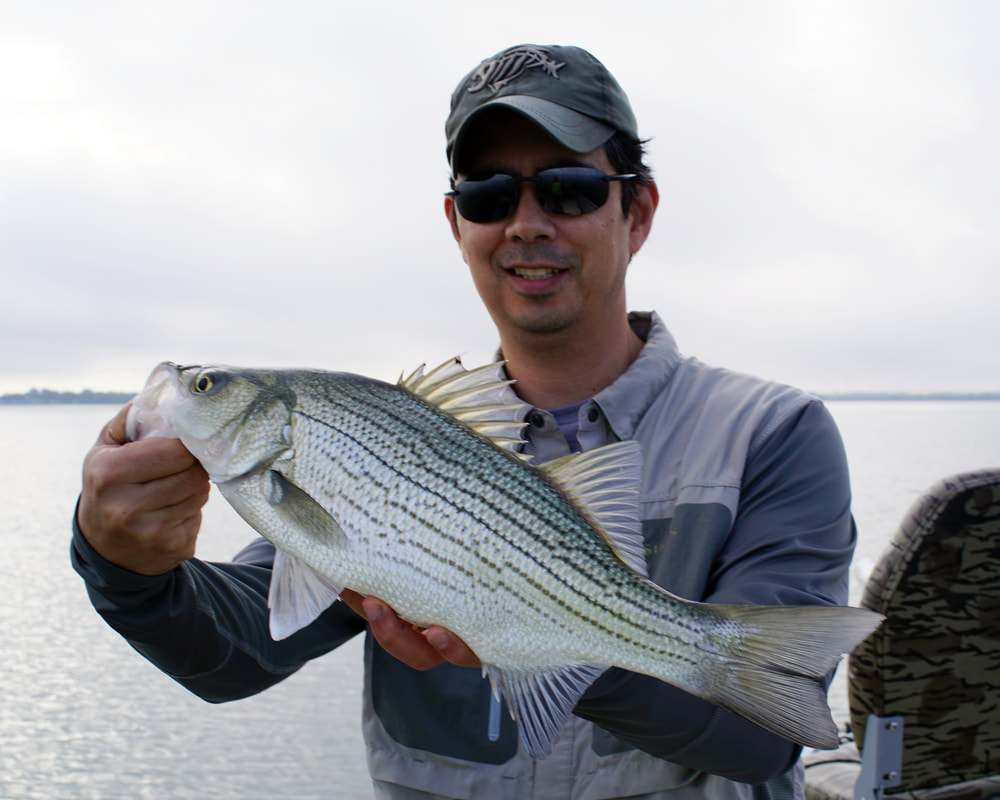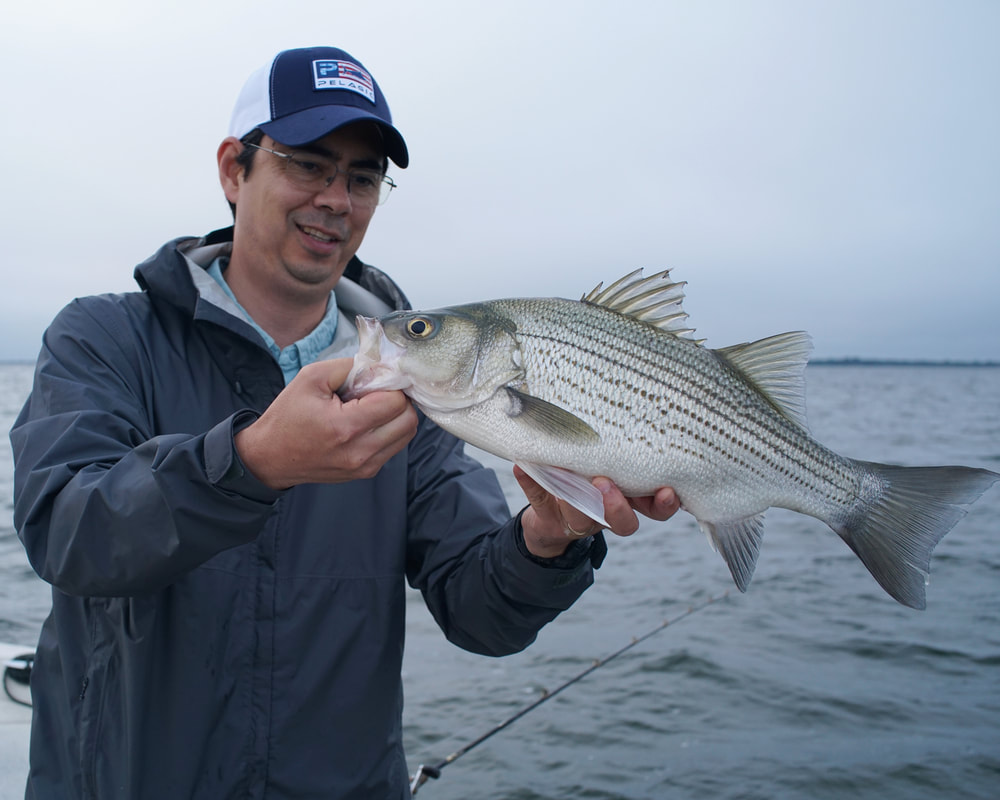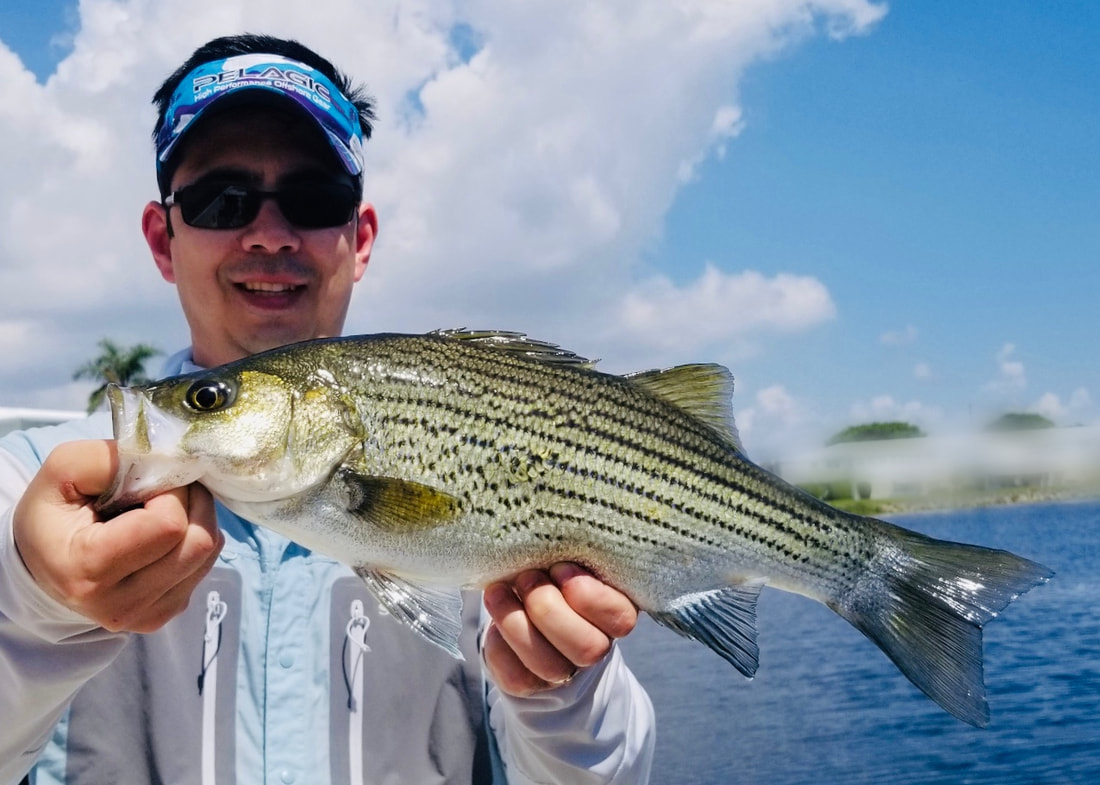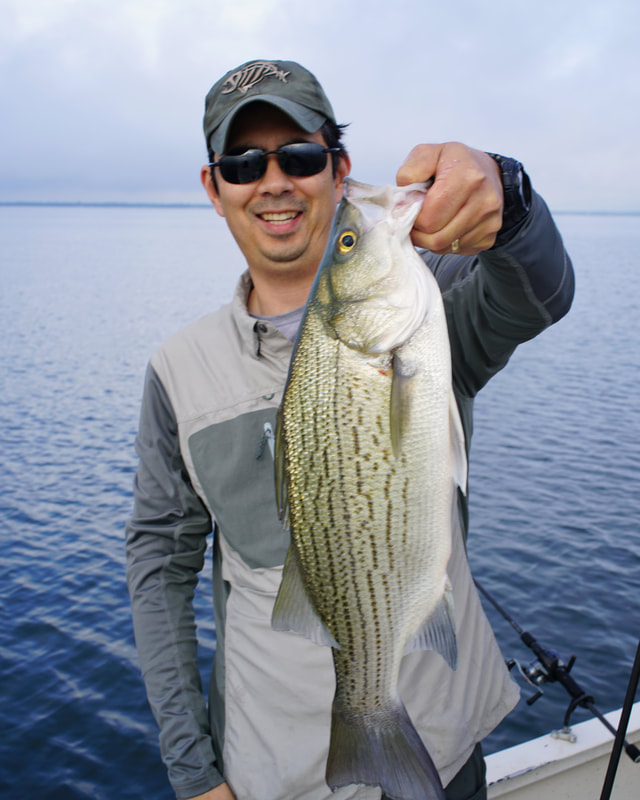Hybrid Striped Bass
HOME
Other Species
Hybrid Striped Bass Description
Hybrid Striped Bass, also called Wipers, Sunshine Bass, and Palmetto Bass, are a good example of how 1+1 can equal 3. They are a cross between a White Bass and a Striped Bass and are more aggressive and fight harder pound for pound than either of their parents. A fish produced using a White Bass mother and a Striped Bass father are called Sunshine Bass, while the offspring of a Striped Bass mother and White Bass father are called Palmetto Bass. The latter is more common because Striped Bass produce a lot of eggs, and are faster growing and attain a larger adult size. They are bred and commonly stocked throughout the United States and are popular for their fighting qualities as well as their food value. They occasionally occur naturally as well.
Hybrids grow quickly and typically live for about 5-7 years. They do not reproduce effectively, but it does happen.
Hybrids are primarily piscivorous, aggressively eating threadfin shad and other small fish that can fit in their mouths. They typically average around 2-5 lbs and max out around 20lbs. Anything over 5lbs will give you a really nice fight.
HOME
Other Species
Hybrid Striped Bass Description
Hybrid Striped Bass, also called Wipers, Sunshine Bass, and Palmetto Bass, are a good example of how 1+1 can equal 3. They are a cross between a White Bass and a Striped Bass and are more aggressive and fight harder pound for pound than either of their parents. A fish produced using a White Bass mother and a Striped Bass father are called Sunshine Bass, while the offspring of a Striped Bass mother and White Bass father are called Palmetto Bass. The latter is more common because Striped Bass produce a lot of eggs, and are faster growing and attain a larger adult size. They are bred and commonly stocked throughout the United States and are popular for their fighting qualities as well as their food value. They occasionally occur naturally as well.
Hybrids grow quickly and typically live for about 5-7 years. They do not reproduce effectively, but it does happen.
Hybrids are primarily piscivorous, aggressively eating threadfin shad and other small fish that can fit in their mouths. They typically average around 2-5 lbs and max out around 20lbs. Anything over 5lbs will give you a really nice fight.
How to Tell the Difference Between White Bass and Hybrids
Here is a side by side comparison of the White Bass and Hybrid. They have similar body shapes, but the Whites are smaller, nearly always less than 16 inches long, and have one single line of black spots that extends all the way to the tail. The Hybrids typically have several lines that extend all the way to the tail, and they are typically darker and bolder. If you want to get really technical they have different tooth patches, but that requires a lot closer examination than most people are going to do. Whites and Hybrids often mix together, which can make things confusing, but usually when you are catching White Bass and hook a Hybrid you can immediately tell from the pull.
Here is a side by side comparison of the White Bass and Hybrid. They have similar body shapes, but the Whites are smaller, nearly always less than 16 inches long, and have one single line of black spots that extends all the way to the tail. The Hybrids typically have several lines that extend all the way to the tail, and they are typically darker and bolder. If you want to get really technical they have different tooth patches, but that requires a lot closer examination than most people are going to do. Whites and Hybrids often mix together, which can make things confusing, but usually when you are catching White Bass and hook a Hybrid you can immediately tell from the pull.
How to Tell the Difference Between Striped Bass and Hybrids
Below is a side by side comparison of a Striped Bass (top), Hybrid (middle), and White Bass (bottom). Stripers have a long slender shape (girth less than 1/3 length), while Hybrids have a more compressed shape (girth more than 1/3 length). Hybrids also tend to have more broken black lines. Stripers attain larger sizes than Hybrids, and any fish over 15lbs is almost certainly a Striper.
Below is a side by side comparison of a Striped Bass (top), Hybrid (middle), and White Bass (bottom). Stripers have a long slender shape (girth less than 1/3 length), while Hybrids have a more compressed shape (girth more than 1/3 length). Hybrids also tend to have more broken black lines. Stripers attain larger sizes than Hybrids, and any fish over 15lbs is almost certainly a Striper.
Hybrid Striped Bass Pound for Pound Fight Rating - 7 out of 10 on the Freshwater Scale
In my view, Hybrid Stripers are the best freshwater pound for pound fighters commonly found in the United States. A 5lber will definitely hit hard, pull some drag, and put up a bulldogging fight. Usually you immediately know when you hook one of these versus other types of fish in the area. If there is cover around, make sure you keep them away from it because they can definitely wrap you up in it if given a chance. Often they are found in open water though, which puts the odds in your favor.
Hybrid Striped Bass Tackle
Medium size freshwater tackle is appropriate for Hybrids. Spinning or baitcasting tackle can work depending on preference. Click here for tackle recommendations.
Hybrid Striped Bass Techniques
The key to catching Hybrid Striped Bass is finding them. They are never too far from their food source, so finding shad often helps you find Hybrids. To locate a school, you can look for surface activity such as boils or diving birds and head over there (without running over them with your boat). This often occurs at first light. Good electronics are needed to consistently find them in big bodies of water if the are not on the surface. If you see them on the surface, topwater lures are a good thing to try. Once they go down, follow them down with spoons and bucktail jigs.
Hybrid Striped Bass get excited when they hear splashing, so sometimes it helps to keep a hooked fish in the water for a little while. Some people also have a trolling motor rigged up to splash on the surface. I don't know how well that works, but lots of people do it so there might be something to it.
Hybrid Striped Bass Lures
Hybrids will hit a variety of lures, most of which resemble shad. Topwaters are a good choice when they are eating shad on the surface, with a variety of shad-like lures producing. When they are in a feeding frenzy it doesn't matter too much what you throw as long as it looks like a shad and you get it in front of them. White and clear shades are good most of the time, with chartreuse being popular when visibility is low.
Swimbaits are a good choice when the fish are in mid-depth, and heavy bucktail jigs and spoons can work well when they are deeper.
Hybrid Bass can be caught by trolling to help locate schools. Alabama rigs work well.
In my view, Hybrid Stripers are the best freshwater pound for pound fighters commonly found in the United States. A 5lber will definitely hit hard, pull some drag, and put up a bulldogging fight. Usually you immediately know when you hook one of these versus other types of fish in the area. If there is cover around, make sure you keep them away from it because they can definitely wrap you up in it if given a chance. Often they are found in open water though, which puts the odds in your favor.
Hybrid Striped Bass Tackle
Medium size freshwater tackle is appropriate for Hybrids. Spinning or baitcasting tackle can work depending on preference. Click here for tackle recommendations.
Hybrid Striped Bass Techniques
The key to catching Hybrid Striped Bass is finding them. They are never too far from their food source, so finding shad often helps you find Hybrids. To locate a school, you can look for surface activity such as boils or diving birds and head over there (without running over them with your boat). This often occurs at first light. Good electronics are needed to consistently find them in big bodies of water if the are not on the surface. If you see them on the surface, topwater lures are a good thing to try. Once they go down, follow them down with spoons and bucktail jigs.
Hybrid Striped Bass get excited when they hear splashing, so sometimes it helps to keep a hooked fish in the water for a little while. Some people also have a trolling motor rigged up to splash on the surface. I don't know how well that works, but lots of people do it so there might be something to it.
Hybrid Striped Bass Lures
Hybrids will hit a variety of lures, most of which resemble shad. Topwaters are a good choice when they are eating shad on the surface, with a variety of shad-like lures producing. When they are in a feeding frenzy it doesn't matter too much what you throw as long as it looks like a shad and you get it in front of them. White and clear shades are good most of the time, with chartreuse being popular when visibility is low.
Swimbaits are a good choice when the fish are in mid-depth, and heavy bucktail jigs and spoons can work well when they are deeper.
Hybrid Bass can be caught by trolling to help locate schools. Alabama rigs work well.
Hybrid Striped Bass Baits
Threadfin shad or other similar baitfish are the way to go if you are going to use bait. Shad are tough to keep alive, and that is an art in itself requiring some knowhow.
Where to Get Big Hybrid Striped Bass
The largest ones are caught in the southern US in Tennessee, Georgia, Arkansas, and Alabama.
If you want to catch Hybrid Striped Bass, I recommend guide Matt Cartwright who fishes Lake Tawakoni in Texas. He can be reached at (214) 415-0166.
Threadfin shad or other similar baitfish are the way to go if you are going to use bait. Shad are tough to keep alive, and that is an art in itself requiring some knowhow.
Where to Get Big Hybrid Striped Bass
The largest ones are caught in the southern US in Tennessee, Georgia, Arkansas, and Alabama.
If you want to catch Hybrid Striped Bass, I recommend guide Matt Cartwright who fishes Lake Tawakoni in Texas. He can be reached at (214) 415-0166.

